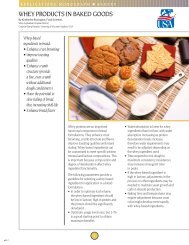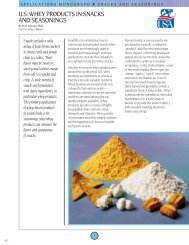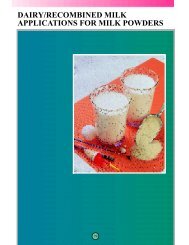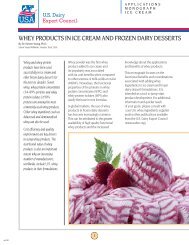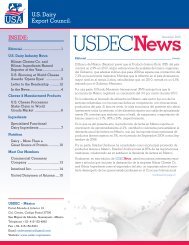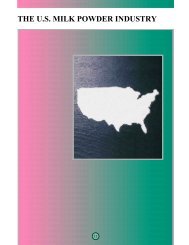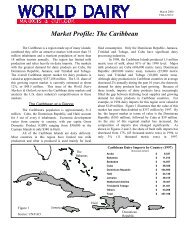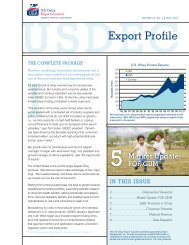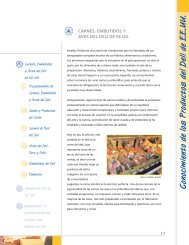USDEC Bakery recipes
USDEC Bakery recipes
USDEC Bakery recipes
- No tags were found...
You also want an ePaper? Increase the reach of your titles
YUMPU automatically turns print PDFs into web optimized ePapers that Google loves.
BAKERYRECIPEBOOKFOR U.S. DAIRY INGREDIENTS
TABLE OFCONTENTSPAGE3-8 INTRODUCTIONBy Kimberlee J. BurringtonWisconsin Center for Dairy Research, Madison, WIandSharon K. GerdesS K Gerdes Consulting, Richlandtown, PABREADS9 White Pan Bread10 Cuerno Bread11 Sweet Buns12 Butter Croissants13 Baking Powder BiscuitsCAKES14 Pound Cake15 Chocolate Cake16 Lemon Cake17 White Layer Cake18 Plain MuffinsCOOKIES19 Wire-Cut Butter Cookies20 Chocolate Chip Cookies21 Shortbread CookiesDOUGH22 Pizza DoughBAKERY23 Waffle MixMIXESBAKERY GLAZES24 <strong>Bakery</strong> Cream Filling25 Reduced-Fat IcingNUTRITIONAL PRODUCTS26 High Protein Energy Bars27 Chocolate Energy Bars28 High Protein Butterscotch Chip CookiesMISCELLANEOUS29 Low-Fat <strong>Bakery</strong> Custard (Flan Style)30 Cake-Type Doughnuts31 Reduced-Fat Brownies32 Lapis Surabaya33 Bolu Gulung34 Custard Éclairs35 <strong>USDEC</strong> OFFICES2Copyright © 2003, <strong>USDEC</strong>. All rights reserved. Printed in U.S.A.
INTRODUCTIONBAKERY APPLICATIONSFOR U.S. DAIRYINGREDIENTSWHEY PRODUCTS IN BAKED GOODSWhey proteins are an important functionalcomponent in bread formulations. They enhancecrust browning, crumb structure and flavor,improve toasting qualities and retard staling.Whey-based ingredients can be customizedto meet specific protein, minerals and lactosecompositions. This is important becausecomposition and degree of denaturation affectwhey ingredient functionality.The following parameters provide a guidelinefor selecting a whey-based ingredient forapplication in a bread formulation:• In order to optimize loaf volume, thewhey-based ingredient should be low inlactose, high in protein and the proteinshould be significantly denatured.• Optimum usage levels vary, but 2%-3%is a good starting point to obtain maximumbenefits.• Water absorption is lower for wheyingredients than for flour, with waterabsorption increasing as proteindenaturation levels increase; thereforewater requirements may need to be adjusteddepending on the whey ingredient used.• Time required to mix dough to maximumconsistency (resistance) may increase(mixogram time to peak).• If the whey-based ingredient is high inlactose, adjustments in the process or otheringredients may be needed to maintain yeastgrowth and carbon dioxide production.• Baking time and temperatures may requireadjusting because crust color might developmore rapidly with whey-based ingredients.Functional BenefitsThere are specific functional properties that areassociated with whey proteins. They include:(1) solubility, (2) water binding/absorption,(3) viscosity, (4) gelation, (5) cohesion, adhesionand elasticity, (6) emulsification and (7) foaming.Most of these characteristics are importantin the processing of baked goods. Thereformulation of bakery products with addedwhey protein (supplementation) is done forfunctional reasons. Whey protein concentrates(WPCs) have found uses in biscuits, cookies,cakes, sponges, icings and glazes to improvetexture and appearance. Dough volume can beincreased in bread and cake, and moistness canbe improved in a variety of products. Wheyprotein isolate (WPI), whey protein concentrate34% (WPC34) and whey protein concentrate 80%(WPC80) have been found to improve the color,thickness and chewiness of full fat and low-fatcookie formulations. WPIs and WPCs withmore than 75% protein can be added tocake formulations to improve volumeand appearance.Whey products are used by the baking industrybecause of their functional benefits. Some of thebenefits recognized by consumers include goodcrust color developed through the Maillardbrowning reaction, good dairy flavor, softercrumb and extended shelf-life. Additionalbenefits that the baker may recognize are theability to reduce ingredient costs by partially orcompletely replacing egg products, milk powderor other ingredients such as shortening. Lesscommonly recognized are the nutritionalbenefits of adding whey proteins to bakeryproducts. Whey proteins have a highconcentration of lysine, the deficient amino-acidin wheat protein. Increasing the ratio of wheyproteins to wheat protein results in an improvedamino-acid profile. Bread, soft rolls and bunsare the major applications for whey products.A typical usage level of whey or lactose inbread, soft rolls and buns is 2%-4% of the flourweight.FunctionalityWhey protein concentrates (WPCs) havemany functional properties, most of which areassociated with the whey proteins. Some of thebasic functionalities that a WPC can provideare whipping/foaming, emulsification, highsolubility, gelation, water binding, and viscositydevelopment. Generally, WPCs with higherprotein content have improved functionality3
INTRODUCTIONover those with lower protein content. Otherfactors that influence their functionality arethe whey source, amount of heat treatmentreceived during manufacture, and lipid andmineral content. Whey protein conformationand functionality are interrelated and dictated bychanges in their globular folded structure. Theirfunctional properties are affected by severalfactors within a food application, includingconcentration, state of the whey proteins, pH,ionic environment, (pre-) heat treatment, andthe presence of lipids. In the native state, wheyproteins are highly soluble and adeptly performemulsification and whipping functions in a foodapplication. Heating whey proteins can result ina loss of solubility due to the denaturation of theproteins, especially in the pH range of 4.0-6.5.While solubility is adversely affected by heat,emulsification can be improved throughcontrolled heat denaturation. As the wheyprotein unfolds, hydrophobic amino acidresidues are exposed, which enhance the abilityof the protein to orient at the oil/water interface.The presence of salts during the emulsificationprocess influences whey protein conformationand solubility. In their undenatured form, wheyproteins can form rigid gels that hold water andfat and provide structural support. The formationof disulfide bonds and ionic bonding controlledby calcium ions appears to determine gel structure.The water-binding abilities of whey proteinscan help reduce formula costs as the proteinshold additional water. Viscosity development isclosely related to gelation and other proteinproteininteractions. Foaming properties arebest when the whey proteins are undenatured,not competing with other surfactants at theair/water interface, and stabilized by an increasein viscosity when foam formation occurs. Wheyproteins also contribute to browning by reactingwith lactose and other reducing sugars presentin a formulation, providing color to heatedproducts. WPCs are also bland tasting andcontribute no foreign or off-flavors when usedas an ingredient.NutritionWhey protein concentrates contribute nutritionto a food application through their mineralcontent as well as their protein content. Wheyproteins are also considered a complete proteinbecause they contain all the essential aminoacids in amounts adequate for human use.They are considered high quality because theycontain the essential amino acids in amountsproportional to the body’s need for them.WPCs also contain significant amounts ofcalcium and other minerals that can be addedadvantages when fortifying food products.Whey Protein Concentrates in BakedProducts: Functionality in Specific ProductsBreadsDairy ingredients have been used extensively inthe development of breads. A softer, more tendercrumb is often produced as a result of wheyproduct addition. Breads made with WPC havealso exhibited these benefits but with somenecessary modifications made to the WPC,to optimize its performance in bread. In testsperformed using WPC34, WPC50 and WPC80in breads, WPC34 produced the softest breadbecause it contained the least amount ofcalcium. The amount of calcium plays a role inthe rate of firming of bread. The mechanismbehind this suggests that lower calcium WPCsaggregate at higher temperatures in the bakingprocess, when there is more gelatinized starch,allowing the whey protein chains to extendbetween the starch chains and decreaseretrogradation. Increasing the lactose contentin the dough can also produce bread thatretains its softness for a longer period of time.This softness has been attributed to betteremulsification of the fat in the formula. Lactosecrystals in baked goods also have unique waterholding capacity. Optimal mixing times wereincreased with the use of all WPCs. When 2%,4% and 6% addition of WPC were tested, the 4 %level of WPC34 yielded the highest loaf volumes.Controlled heat treatment of WPC34 to achieve4
INTRODUCTIONpartial denaturation of the whey proteins hasalso been shown to improve bread moistnessand texture.Decreasing fermentation time is detrimentalto bread quality when using WPCs. Typically,the shorter the fermentation time, the moresensitive the bread is to whey proteins. WPCs(up to 2% protein addition) have been used inbread made by the sponge dough process.The bread quality was improved by using highprotein WPC, denaturing the protein to the samedegree as for high heat nonfat dry milk andadding sodium stearoyl-2-lactylate. Generally,the higher the protein content of the WPC,the greater the loss in loaf volume. Besidesimproving the softness of bread, WPCs are oftenused to perform many of the functions of eggs inbaked products.CakesIn cakes, more protein is needed for crumbstrength. The finished structure of a cake isdependent upon the gelatinization of starch anddenaturation of protein. The addition of sugar incakes increases the gelation temperature ofgluten so the finished structure of the cakecannot be obtained without the addition of aprotein with a lower gelation temperature.Whole eggs and egg whites are added to achievethis desired structure. Successful application ofWPC as egg replacers in cakes is inversely relatedto the sugar and fat level in the cake system.Egg whites in cakes can be partially or totallyreplaced with WPCs with a high protein content(WPC80). The higher the sugar and the lower thefat, the harder it is to make an acceptable cakewith a complete replacement of whole egg withWPC. The higher protein WPCs generally arerequired for cake applications because of therequirement for gelation.The WPC34, WPC50, and WPC80 products arewell suited to partially replace the functions ofwhole egg in a cake application. WPC80 is bettersuited for egg white replacement. WPCs canprovide body and viscosity to cake battersto help entrap air and retain carbon dioxideproduced by the leavening system. They can alsohelp in retaining moisture in cakes. Anotheringredient that can be replaced in a bakedproduct is fat. The addition of WPC80 (at a 2%level) to a low-fat pound cake formula canresult in a higher volume, softer product that ispreferred over both a full fat control and a low-fatcontrol (no WPC80) in moistness, flavor andoverall characteristics.CookiesReplacement of whole egg with WPC in a softcookie is also possible. In less aerated products,such as cookies, replacement of skim milkpowder or egg is easily accomplished. Wheyadded to cookies is an economical source ofdairy solids. Both WPC34 and WPC80 havebeen found to improve the color, thickness, andchewiness of cookies. In reduced-fat cookies,combinations of WPC80, modified starch,emulsifiers and water are able to replace wholeeggs and shortening. This addition results inbatters with similar spread and in baked cookieswith similar texture, flavor and overall preferencewhen compared to the control. Egg whites informulas for scones and crepes can be replacedwith WPC80. The substitution is made on anequal protein basis. The resulting products aresimilar to control products in overall acceptance,but they are generally more tender in texture.Pie CrustsWhey or lactose can be added to pie crusts.Whey at approximately 2%-3% or lactose at6%-8% of flour weight aid in emulsifying theshortening. This allows for a reduction inshortening without sacrificing the tender, flakytexture. Bakers also report improvements incolor and flavor of the baked crust.<strong>Bakery</strong> Mixes<strong>Bakery</strong> mixes are generally one of threedifferent types: complete mix (only requirethe addition of water), dough base and doughconcentrate. Dough bases or partial mixesrequire that the end-user adds water as well asoil or shortening and eggs. Dough concentratesare specifically designed for continuous, highthroughput, automated production. Used for fatreduction, high solubility, water binding, and5
INTRODUCTION6moisture retention, they blend well with otheringredients in a bakery dry mix. Mild flavor isanother attribute of WPCs that typically blendswell with baked products. The bland, dairy flavorof WPC enhances many of the browning typeflavors that develop during baking. The addedbrowning that results due to the lactose contentalso contributes to an appealing surface color.CrackersIn contrast to cookies, crackers contain littleor no sugar. They are formulated with higherprotein flours, often a mixture of soft and hardwheat. The functional requirements for WPC incrackers are similar to that in breads. WPC hasbeen used to replace flour in yeast leavenedcrackers. WPC34 gives superior results overWPC75 (when using WPC75, less than 5% ofthe flour can be replaced). The longer thefermentation time, the more satisfactory isthe cracker.<strong>Bakery</strong> Glazes<strong>Bakery</strong> glazes based upon whey proteinconcentrates and caseinates have numerousadvantages over traditional glazes made fromwhole eggs and water. The whey-based glaze ismicrobiologically stable and salmonella-free. Ittends to be less prone to microbial growth in theholding tank, although good sanitation practicesare always necessary. As a top spray on proofedbread or rolls, this type of glaze gives goodadhesion of toppings such as seeds andcrushed grains.Nutritional ProductsAnother area where WPCs deliver a tangiblebenefit is that of baked products designed for thenutritionally conscious. Products such as energybars or sports bars often are fortified with proteiningredients and minerals. WPC80 products areideal for these applications because WPC80brings not only high protein concentrations butalso the highest level of calcium, which couldreduce the need to add additional calcium in avitamin, fortified product. Protein fortificationis an excellent application for WPCs. Moreemphasis will likely be placed on thecontributions of both protein and mineralsin main stream food products. With proteinlevels ranging from 34%-80% in WPCs andcalcium levels from 500-600mg per100gof product, WPCs have a lot to contributenutritionally to an application. Specialty breadsmay be an area of interest as well as the cerealbar or energy bar type products.The typical levels used in baked products canadd small benefits to the overall nutrition of theproduct. The best returns nutritionally are foundin fat replacement. Replacing fat with proteinhas nutritional label appeal to most consumers.Processing ConsiderationsThere is a need to maintain consistentprocessing conditions for all WPCs so consistentfunctionality can be delivered to the customer atall times. It is also necessary for the applicationstechnologist to understand the processes forpreparation of each baked product and whatchanges would have to be made to easilyincorporate a WPC. Whether it is proof time,mixing times, order of addition of ingredientsor levels of ingredients, optimization isneeded whenever ingredient changes aremade to a formula.Consistent quality is of great importance to acustomer. Many U.S. manufacturers of WPCshave the capabilities of producing consistent,high quality products. It is important for theircustomers to work closely with them so they canunderstand their quality and functionality goals.USING LACTOSE AND PERMEATE INBAKED GOODSWhey permeate is a cost-efficient source of dairysolids for bakery applications, which enhancescrust browning, improves flavor, retainsmoisture, serves as a source of calcium andmay be used as a salt replacer.Also known as dairy product solids orde-proteinized whey, whey permeate is acost-efficient ingredient that finds many uses inbakery applications. Typical food grade permeatecontains 65% to 85% lactose, 8% to 20% ash, and
INTRODUCTION3% to 8% protein. Maximum fat content is1.5%.Usage levels for permeate range from 2% to 5%in breads, rolls and cookies to 5% to10% inbiscuits and muffins.Lactose is a disaccharide obtained from whey orpermeate. Edible or food grade lactose containsa minimum of 99% lactose, 0.1% to 0.3% ash,and 0.6% to 0.1% protein. The lower ash contentallows for higher usage levels in a wide variety ofbaked goods.Lactose can be used in baking to achieve specificfunctional benefits. Lactose works well in bakedapplications where ash and protein mightcause undesired side effects, or where a morecontrolled application is desired. Also, lactoselowers sweetness, increases browning, retainsmoisture and enhances flavors.Key Benefits for BakersCrust Color DevelopmentUnlike sucrose, the lactose in whey permeate is areducing sugar. Thus it is able to contribute tobrown crust formation through both Maillardbrowning and caramelization. The Maillardreaction creates browning through a reactionbetween a reducing sugar and amino acids orproteins. Increasing temperature, increasing pH,and lowering water activity all increase the rateof Maillard browning. Caramelization occursthrough a series of dehydration, condensationand polymerization reactions. Lactose turnsyellow when heated to150° to160°C and brownsat175°C.Lactose and permeate are very efficient asbrowning agents, and sometimes bake timesand temperature may need to be adjusted.Individual applications may vary, but someformulas would benefit by a reduction in baketemperature of 25°C, with a correspondingincrease in bake time to achieve a golden browncrust without excess browning. Permeate mayproduce some slight variations in crust color. Inapplications where a very uniform crust color isdesired, choose lactose or a higher value dairyingredient such as skim milk powder.The controlled browning of lactose proteinmixtures is highly desirable for the browning offoods in microwaves, where the lower surfacetemperatures that occur are insufficient for thebrowning produced in the conventional process.Sweetness and FlavorThe relative sweetness of lactose is lowcompared to other sweeteners. Lactose hasapproximately15% to 30% of the sweetnesslevel of sucrose. The lower sweetness allowslactose or permeate to be used in applicationswhere higher solids are desired withoutexcess sweetness. Maillard browning andcaramelization of lactose contribute to toastedbrown and burnt sugar notes.Lactose has a strong affinity for flavorings andflavors. Its unique volatile flavor-binding andenhancing properties are particularly useful inbakery products with delicate flavors. Becauselactose binds volatile flavor components, thereis less flavor loss during processing and storage.Permeate can enhance and complement certainbakery flavors such as spice, coconut, vanillaand chocolate.FermentationIn yeast-raised products such as bread and rolls,lactose is not fermented, and thus can be usedat higher levels than sucrose without affectingyeast activity. In general, sugars are neededfor fermentation to progress, and salts retardfermentation. On a dry basis, a typical leanwhite bread formula might contain 2% sugar,2% salt, and up to 5% nonfat dry milk.Whey permeate could be used in this system,with subsequent reductions in the other threeingredients. The minerals in permeate will exertan inhibitory effect on yeast activity, and thus willlimit usage levels.Lactose is much less soluble than sucrose, andconsequently it does not affect the level of freewater necessary for yeast activity. The addition oflactose shortens proofing time, especially wherethe overall level of sugar is high. Lactose gives amore elastic dough and increases bread volume.Lactose also improves kneading characteristicsand improves stability and gas retention.7
INTRODUCTIONLactose should be added to the dry ingredients,and should not be dissolved in the aqueousphase. The positive lactose function seemsrelated to the fact that it is in a crystallinestage during fermentation but dissolves inthe aqueous phase during baking.Moisture RetentionStaling or firmness of bread results primarilyfrom starch retrogradation, a complex processthat involves recrystallization. Lactose does notrecrystallize after cooling and thus helps retardstaling over time. In addition, lactose functionsas a humectant to extend the shelf life of bakedgoods. Lactose and permeate also impedegluten formation, resulting in a more tendercrumb structure. Lactose extends shorteningin bakery products, enabling a fat reduction incertain <strong>recipes</strong>.Salt SubstitutionWhey permeate may be used to replace part orall of the salt in baked goods. The salt level ofpermeate may be a limiting factor in some sweetapplications. In pound cake, it was found thatwhen used at a level of 5%, permeate couldreplace part of the dairy and sugar componentsand all of the salt. Levels above 5% resulted inan overly salty product. In general, reducing thesalt will permit a higher level of permeate use.Permeate works well in cheese and savoryapplications such as pizza crust, cheese bagels,herb breads and biscuits.Hydrolyzed Lactose SyrupBy treating liquid whey permeate with animmobilized enzyme, it is possible to producea hydrolyzed lactose syrup. This ingredienthas found use in bakery applications in someEuropean countries. Research has shownpositive results with a product with 50% to 75%hydrolysis and some level of demineralization.However, this product is not widely used oravailable at this time.LACTOSE FUNCTIONALITYIn baking, lactose is often used to replacesucrose for a variety of functional benefits.Compared to other sugars, lactose results inlow relative sweetness, increased browning,enhanced emulsification action, moistureretention, non-hygroscopicity and enhancedflavors. When replacing sucrose (up to 50%),lactose can contribute to improved crumbtexture and freshness, increased volume,reduced fat levels, improved gas retention, andenhanced flavor. Lactose also shortens proofingtimes, especially where the overall sugar levelis high. Doughs containing lactose show atendency to rise faster during the initial stagesof proofing and show improved stability and gasretention. Lactose readily reacts with proteins(Maillard reaction) giving baked goods ahighly flavored, desirable golden-brown color.Caramelization by heat during baking alsocontributes flavor and color. Lactose influencesand enhances the controlled browning of bakerygoods, leading to shorter baking times and lowertemperatures to achieve even, stable, goldenbrown colors. This is a particular benefit inproducts targeted for microwave finishing.Lactose has unique, volatile flavor binding andenhancing properties, which are particularlyuseful in products with delicate flavors. Lactosehas a strong affinity for flavorings and flavors.It is able to absorb and accentuate flavors. Thisenables a reduction in added flavors.Lactose also extends shortening in bakeryproducts, enabling a fat reduction in certain<strong>recipes</strong>. Since lactose is not fermented by baker’syeast, it retains its functionality characteristicsthrough baking and storage.8



